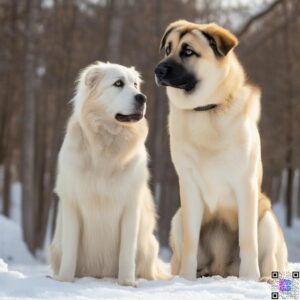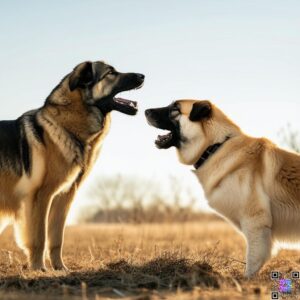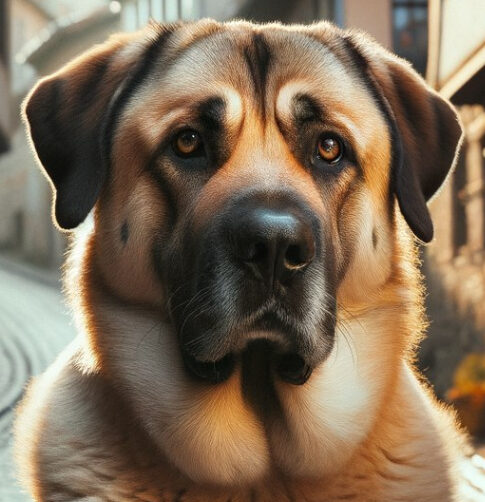Introduction
The Central Asian Shepherd Dog and Anatolian Shepherd Dog are two ancient breeds known for their impressive size, protective instincts, and loyal nature. Both breeds have been used for centuries to guard livestock and protect their families. While they share some similarities, they also have distinct differences in terms of their physical characteristics, temperament, and behavior. In this article, we will delve into the key differences and similarities between these two magnificent breeds, helping you make an informed decision if you are considering bringing one home.
The Central Asian Shepherd Dog
Originating from the vast steppes of Central Asia, the Central Asian Shepherd Dog, also known as Alabai, has been bred for centuries to protect livestock from predators like wolves and bears. Their history as guardians has shaped their robust physical traits and strong temperament.
- Origin and History
The Central Asian Shepherd’s roots trace back thousands of years, where they were utilized by nomadic tribes to safeguard flocks. This breed is known for its resilience in harsh climates and its ability to work independently. - Physical Characteristics
These dogs are large and muscular, often weighing between 90 to 150 pounds. They possess a thick double coat that can withstand extreme temperatures, making them well-suited for outdoor life. - Temperament and Behavior
Known for their loyalty and protective nature, Central Asian Shepherds can be aloof with strangers but are affectionate with family members. They require consistent training and socialization from an early age to ensure they grow into well-adjusted adults. - Health Considerations
While generally healthy, these dogs can be prone to hip dysplasia and certain genetic conditions. Regular veterinary check-ups and a balanced diet are crucial for maintaining their health.
The Anatolian Shepherd Dog
The Anatolian Shepherd Dog, hailing from Turkey, has also been a vital part of livestock protection for centuries. Known for their intelligence and independence, these dogs have unique traits that differentiate them from their Central Asian counterparts.
- Origin and History
Like the Alabai, the Anatolian has a rich history as a guardian dog. They were bred by farmers to protect sheep from predators in the rugged terrain of Anatolia. - Physical Characteristics
Anatolians are slightly smaller than their Central Asian counterparts, typically weighing between 80 to 150 pounds. They have a short coat that is less dense but still offers protection against the elements. - Temperament and Behavior
These dogs are known for their calm demeanor and intelligence. They tend to be more social than Central Asians but still retain a strong protective instinct. Early training is essential to harness their intelligence effectively. - Health Considerations
Common health issues include hip dysplasia and eye problems. Regular exercise and mental stimulation are necessary to keep them healthy both physically and mentally.
Physical Characteristics

Size and Build
The Central Asian Shepherd Dog is a large breed, standing at a minimum of 70 cm (28 inches) tall at the shoulder, with males weighing over 50 kg (110 pounds) and females weighing over 40 kg (85 pounds). The Anatolian Shepherd Dog is slightly taller, with males reaching 74-81 cm (29-32 inches) and females reaching 71-79 cm (28-31 inches), weighing 50-65 kg (110-145 pounds) for males and 40-55 kg (85-120 pounds) for females.
Coat and Color
Both breeds have thick double coats, but the Central Asian Shepherd Dog’s coat is generally shorter and more dense, while the Anatolian Shepherd Dog’s coat is longer and more flowing. The Central Asian Shepherd Dog comes in a wide range of colors, including white, black, red, and fawn, while the Anatolian Shepherd Dog is typically red, fawn, or white with a black mask.
Head and Skull
The Central Asian Shepherd Dog has a flat skull with a well-defined occiput and a moderate stop, while the Anatolian Shepherd Dog has a slightly domed skull with a more pronounced stop. The muzzle of the Central Asian Shepherd Dog is almost rectangular in shape, while the Anatolian Shepherd Dog’s muzzle is more tapered.
Eyes and Ears
The eyes of the Central Asian Shepherd Dog are medium-sized and oval, set straight ahead, while the Anatolian Shepherd Dog’s eyes are slightly larger and more almond-shaped. The ears of both breeds are medium-sized and triangular in shape, but the Central Asian Shepherd Dog’s ears are slightly more rounded at the tip.
Temperament and Behavior
Protective Nature and Training
Both breeds are known for their protective instincts and require early socialization and training to ensure they are well-behaved and obedient. The Central Asian Shepherd Dog is generally more independent and less food-motivated, while the Anatolian Shepherd Dog is more food-motivated and requires consistent training.
Health and Lifespan
Common Health Issues and Average Lifespan
Both breeds are prone to certain health issues, such as hip dysplasia and eye problems. The Central Asian Shepherd Dog typically lives for 12-15 years, while the Anatolian Shepherd Dog lives for 10-14 years.
Comparison Summary
Key Differences and Similarities
In summary, the Central Asian Shepherd Dog and Anatolian Shepherd Dog share many similarities, including their large size, protective instincts, and loyal nature. However, they differ in terms of their physical characteristics, temperament, and behavior. The Central Asian Shepherd Dog is generally more independent and less food-motivated, while the Anatolian Shepherd Dog is more food-motivated and requires consistent training. When choosing between these breeds, consider your lifestyle, living situation, and the level of training and socialization you are willing to provide.

FAQs
1- Are Central Asian Shepherd Dogs and Anatolian Shepherd Dogs good with children?
2- Are Central Asian Shepherd Dogs and Anatolian Shepherd Dogs good watchdogs?
3- Can Central Asian Shepherd Dogs and Anatolian Shepherd Dogs be kept in apartments?
4- Are Central Asian Shepherd Dogs and Anatolian Shepherd Dogs prone to health issues?
5- How long do Central Asian Shepherd Dogs and Anatolian Shepherd Dogs live?
6- Are Central Asian Shepherd Dogs and Anatolian Shepherd Dogs easy to train?
7- Are Central Asian Shepherd Dogs and Anatolian Shepherd Dogs good with other pets?
8- Can Central Asian Shepherd Dogs and Anatolian Shepherd Dogs be used for herding?
9- Are Central Asian Shepherd Dogs and Anatolian Shepherd Dogs expensive to maintain?
10- Are Central Asian Shepherd Dogs and Anatolian Shepherd Dogs recognized by kennel clubs?
11- Can Central Asian Shepherd Dogs and Anatolian Shepherd Dogs be used for search and rescue?
12- Are Central Asian Shepherd Dogs and Anatolian Shepherd Dogs good for first-time dog owners?
13- Can Central Asian Shepherd Dogs and Anatolian Shepherd Dogs be used for therapy work?
14- Are Central Asian Shepherd Dogs and Anatolian Shepherd Dogs good for families with small children?
15- Can Central Asian Shepherd Dogs and Anatolian Shepherd Dogs be used for guarding?
16- Are Central Asian Shepherd Dogs and Anatolian Shepherd Dogs good for people with allergies?
17- Can Central Asian Shepherd Dogs and Anatolian Shepherd Dogs be used for hunting?
18- Are Central Asian Shepherd Dogs and Anatolian Shepherd Dogs good for people who live in apartments?
19- Can Central Asian Shepherd Dogs and Anatolian Shepherd Dogs be used for agility training?
20- Are Central Asian Shepherd Dogs and Anatolian Shepherd Dogs good for people who have limited mobility?
21- Can Central Asian Shepherd Dogs and Anatolian Shepherd Dogs be used for search and rescue?
22- Are Central Asian Shepherd Dogs and Anatolian Shepherd Dogs good for people who have allergies?
23- Can Central Asian Shepherd Dogs and Anatolian Shepherd Dogs be used for therapy work?
24- Are Central Asian Shepherd Dogs and Anatolian Shepherd Dogs good for families with small children?
25- Can Central Asian Shepherd Dogs and Anatolian Shepherd Dogs be used for guarding?
26- Are Central Asian Shepherd Dogs and Anatolian Shepherd Dogs good for people with allergies?
27- Can Central Asian Shepherd Dogs and Anatolian Shepherd Dogs be used for hunting?
28- Are Central Asian Shepherd Dogs and Anatolian Shepherd Dogs good for people who live in apartments?
29- Can Central Asian Shepherd Dogs and Anatolian Shepherd Dogs be used for agility training?
30- Are Central Asian Shepherd Dogs and Anatolian Shepherd Dogs good for people who have limited mobility?
31- Can Central Asian Shepherd Dogs and Anatolian Shepherd Dogs be used for search and rescue?
32- Are Central Asian Shepherd Dogs and Anatolian Shepherd Dogs good for people who have allergies?
33- Can Central Asian Shepherd Dogs and Anatolian Shepherd Dogs be used for therapy work?
34- Are Central Asian Shepherd Dogs and Anatolian Shepherd Dogs good for families with small children?
35- Can Central Asian Shepherd Dogs and Anatolian Shepherd Dogs be used for guarding?
36- Are Central Asian Shepherd Dogs and Anatolian Shepherd Dogs good for people with allergies?
37- Can Central Asian Shepherd Dogs and Anatolian Shepherd Dogs be used for hunting?
38- Are Central Asian Shepherd Dogs and Anatolian Shepherd Dogs good for people who live in apartments?
39- Can Central Asian Shepherd Dogs and Anatolian Shepherd Dogs be used for agility training?
40- Are Central Asian Shepherd Dogs and Anatolian Shepherd Dogs good for people who have limited mobility?
41- Can Central Asian Shepherd Dogs and Anatolian Shepherd Dogs be used for search and rescue?
42- Are Central Asian Shepherd Dogs and Anatolian Shepherd Dogs good for people who have allergies?
43- Can Central Asian Shepherd Dogs and Anatolian Shepherd Dogs be used for therapy work?
44- Are Central Asian Shepherd Dogs and Anatolian Shepherd Dogs good for families with small children?
45- Can Central Asian Shepherd Dogs and Anatolian Shepherd Dogs be used for guarding?
46- Are Central Asian Shepherd Dogs and Anatolian Shepherd Dogs good for people with allergies?
47- Can Central Asian Shepherd Dogs and Anatolian Shepherd Dogs be used for hunting?
48- Are Central Asian Shepherd Dogs and Anatolian Shepherd Dogs good for people who live in apartments?
49- Can Central Asian Shepherd Dogs and Anatolian Shepherd Dogs be used for agility training?
Conclusion
In conclusion, the Central Asian Shepherd Dog and Anatolian Shepherd Dog are both magnificent breeds that can make wonderful companions for the right owner. By understanding their unique characteristics and needs, you can make an informed decision about which breed is best for you. Remember to consider factors such as your lifestyle, living situation, and the level of training and socialization you are willing to provide. With the right care and attention, either breed can thrive and become a loving and loyal companion.
